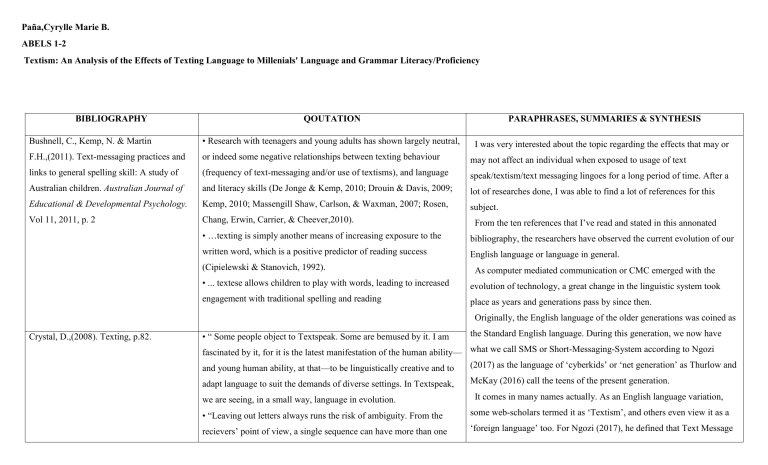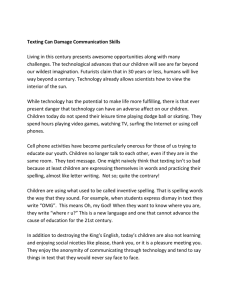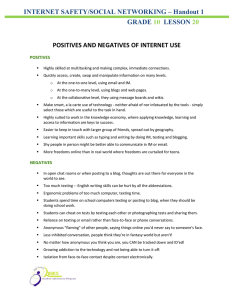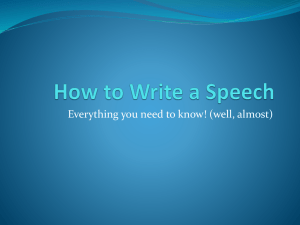
Paña,Cyrylle Marie B.
ABELS 1-2
Textism: An Analysis of the Effects of Texting Language to Millenials' Language and Grammar Literacy/Proficiency
BIBLIOGRAPHY
QOUTATION
PARAPHRASES, SUMMARIES & SYNTHESIS
Bushnell, C., Kemp, N. & Martin
• Research with teenagers and young adults has shown largely neutral,
F.H.,(2011). Text-messaging practices and
or indeed some negative relationships between texting behaviour
may not affect an individual when exposed to usage of text
links to general spelling skill: A study of
(frequency of text-messaging and/or use of textisms), and language
speak/textism/text messaging lingoes for a long period of time. After a
Australian children. Australian Journal of
and literacy skills (De Jonge & Kemp, 2010; Drouin & Davis, 2009;
lot of researches done, I was able to find a lot of references for this
Educational & Developmental Psychology.
Kemp, 2010; Massengill Shaw, Carlson, & Waxman, 2007; Rosen,
subject.
Vol 11, 2011, p. 2
Chang, Erwin, Carrier, & Cheever,2010).
I was very interested about the topic regarding the effects that may or
From the ten references that I‟ve read and stated in this annonated
• …texting is simply another means of increasing exposure to the
bibliography, the researchers have observed the current evolution of our
written word, which is a positive predictor of reading success
English language or language in general.
(Cipielewski & Stanovich, 1992).
As computer mediated communication or CMC emerged with the
• ... textese allows children to play with words, leading to increased
evolution of technology, a great change in the linguistic system took
engagement with traditional spelling and reading
place as years and generations pass by since then.
Originally, the English language of the older generations was coined as
Crystal, D.,(2008). Texting, p.82.
• “ Some people object to Textspeak. Some are bemused by it. I am
the Standard English language. During this generation, we now have
fascinated by it, for it is the latest manifestation of the human ability— what we call SMS or Short-Messaging-System according to Ngozi
(2017) as the language of „cyberkids‟ or „net generation‟ as Thurlow and
and young human ability, at that—to be linguistically creative and to
adapt language to suit the demands of diverse settings. In Textspeak,
we are seeing, in a small way, language in evolution.
McKay (2016) call the teens of the present generation.
It comes in many names actually. As an English language variation,
• “Leaving out letters always runs the risk of ambiguity. From the
some web-scholars termed it as „Textism‟, and others even view it as a
recievers‟ point of view, a single sequence can have more than one
„foreign language‟ too. For Ngozi (2017), he defined that Text Message
meaning...”
particular group or region for communication—which is more like
Dansieh, S.,(2011). SMS Texting and Its
Potential Impacts on Students‟ Written
• …over 50% of teachers said that they did see abbreviations and text
Communication Skills. International
language in student written assignments.
Journal of English Linguistics 1.2
Ling, L., (2010). Texting as a life phase
medium. Computer Mediated Journal,
doi:10.1111/j.1083-6101.2010.01520.x, p. 2
language as not entirely a language but a peculiarity in language to a
lingoes instead. Now, this contradicts to what Tagg (2012), Crystal
(2008), Thurlow (2016), Tagliomente, Lee and Humphry‟s opinion,
where textism/textese/textspeak is another form of evolution in language.
With how the world continues to change, it‟s only normal that there will
• It offered them an inexpensive and a discreet form of communication
within their peer groups. In addition, it provided them with an arena in
which they could play with the language and develop different forms
of slang and internal forms of interaction. In this way texting was seen
as a way in which teens could define themselves vis-`a-vis parents and
other groups (Ling, 2008c; Oksman & Turtiainen, 2004).
be some certain changes in some aspect of our lives in order to adapt and
survive.
But the real question here is, is this change bad or good for us?
According to the researchers for An Analysis of Language in University
Students’ Text Messages, textism, a form of a foreign language by others
does have a positive and negative effects on an individuals‟ literacy
skills, which is highly supported by several researchers too who dabbles
Lyddy, F., Farina, F., Hanney, J., Farrell, L.,
•The prevalence of textisms within text messages has been
& O‟ Neill, N.K. (2013). An Analysis of
exaggerated in the media, with some descriptions treating text
Language in University Students‟ Text
messaging as if it were a „foreign‟ language (e.g., see Crystal, 2008
textism/textese/text speak/text lingoes in students literacy skills have
Messages. Journal of Computer-Mediated
a,b; Jones & Schieffelin, 2009; Thurlow, 2006)
shown that it negatively affected their formal writing skill. Teachers
Communication, doi:10.1111/jcc4.12045, p.
•Plester and Wood‟s (2009) study of preteens found no negative
even reported on a survey that 50% of their students essays and
547-548.
effects on literacy for young users. Some studies have reported a
assignments have a mix of textism/textese/text speak/text lingoes
on this same issue.
Certain researches conducted regarding the effects of
positive effect of texting on children‟s literacy skills (e.g. Plester et al., (Dansieh, 2011) which literally frustrates them in anger, (Lee). Students
2009), although phonological skills may mediate some of that
who uses the SMS standard also proclaims that not only their writing
relationship (see Wood et al., 2011). Some studies have noted negative literacy skills were negatively affected but also showed in their vocal
effects on literacy skills, however.
speech. According to Tagliomonte, abbreviations, acronyms and
•Rosen, Chang, Erwin, Carrier and Cheever‟s (2010) study of young
misspelling of the words in CMC have influenced both the written and
adults showed a negative association between self-reported textism
spoken language with overuse of it in due time. Grammatical errors
use and formal writing, while there was a positive association with
informal writing. However, self-reported textism use was quite low in
occur through iterative omissions and confusion in recalling the correct
this case and may or may not reflect actual use of textisms.
form of words and spelling happens when they revert back to Standard
•Kemp (2010), using a textism translation/generation task, found that
English in writing formal academic and literary compositions.
messages using textisms were faster to write than those in standard
Not long then, some people already heavily criticize and rejects textism.
English, but they took nearly twice as long to read, and were
Sutherland even dare to say that textism is just a mask for the
associated with more reading errors.
Ngozi, O.G.,(2017). Text Message Lingoes
• The fact that words that do not normally have abbreviations are
in a Dynamic Society. Ibadan Journal of
compressed and the vowel or consonant content eliminated as often
English Studies, Volume 12, p.2,7, 10
characterised by text message lingoes, subjects the reader to the
difficult task of decoding what the writer has in mind. Sometimes,
this leads to the misinterpretation and misunderstanding of the
sentence and the intended message.
• The new quests to economize energy, save costs, save time and take
short cuts in communication, have however, degenerated to what is
today known as Short Message System (SMS).
• To them [ Crystal & Schieffellin] “textism arguably demonstrates an
appreciation of sounds of language and has posed no negative effects
on literacy for young users.
• Ling (2010) cross-sectional analysis suggests that texting follows a
life- phase pattern, with older teens and those in their early 20s
making the most use of the medium, with usage dropping off with age.
• Though text messaging is perceived as fast and cost effective,
personal and nonintrusive with a distinctive style of writing, it is
embedded with various inconsistences which pose a threat to the
proper understanding of the intended messages.
illiterates…a penmanship for the illiterates and mentally lazy people. A
dialect that is bald, bleak, thin, unimaginative and pure drab shrinktalk.
It was also supported by Humphry‟s statement from Tayebenik‟s
journal of Txt msg n English Language Literacy, as he describes texting
as a type of vandalism that pillage,rapes and destroy our language. Even
Bushnell, Kemp and Martin seems to stand againts textism.
On a more positive outlook in text messaging, according to Dr. Caroline
Taggs‟ interview, conducted by Andy Tootel about The Language of
Text Messaging and Social Networks, text messaging deviating from an
analytical angle, is just another language variation that offers another
medium or format of communication where they can freely express their
selves to a degree that they can construct a wide variety of expressions
and forms for every different context it‟s being used.
This is also subversive to Crystals‟(2008) view in “Texting” as text
speak being an evidence to humanity‟s ability to adapt to change, and
evolve to survive in a diverse setting which is shown in a small way
through our text speak language.
We can also say that Tagg (2012) and Crystal‟s (2008) stand on text
speak having an ambigous character for it‟s ability to contain different
meanings and never having a fixed form and is full of inconsistencies.
Sutherland, J.(2002). Cn u txt?The
•„thin and unimaginative… mask[ing] dyslexia, poor spelling and
Guardian, Nov. 11th 2002. Retrieved on
mental laziness… penmanship for illiterates‟
18th August 2010 from,
• As a dialect, text ('textese'?) is thin and unimaginative. It is bleak,
But in Tagliamonte, Sali & Denis, Derek, Tagg, Crystal and Ling‟s
case, this may not be really a problem.
Based on their statements, textism‟s inconsistency and ability to have
http://www.guardian.co.uk/technology/2002/ bald, sad shorthand, drab shrinktalk. The dialect has a few hieroglyphs
many different meanings and forms is actually a good point of this
nov/11/mobilephones2.
(codes comprehensible only to initiates) and a range of face symbols.
language. This, according to them shows a great deal of humanities
… Linguistically it's all pig's ear. … Texting is penmanship for
ability to be creative in expressing not only in vocal speech but also in
illiterates.
writings. Rather than view textism as changing language as a whole, why
• “…people are perhaps not overly concerned with cutting the
message down. Research suggests that people are more concerned
with not so much getting their point across but saying what they want
to say in the way they want to say it to a friend. So, it's all about
building up relationships and expressing yourself and that sort of
thing. So, people will use more words if that‟s necessary.”
• “The thing about texting and to an extent, other forms of online
communication, is that you can‟t use gesture and intonation, facial
Tagg.(2012).http://www.ideaslab.bham.ac.u
expressions and other things we take for granted when we‟re speaking.
k/ideaslab_podcast.htm.
I think to an extent that encourages people to make puns and play with
the language to express themselves.”
• “…language change and one is language variation. So with language
variation it‟s important to understand that there are different varieties
of one language, so where language varies according to the context
it‟s being used in, or the reason it‟s being used, so you have the
language of academic writing and the language of science, the
language of biology and the language of physics and you have the
language of newspapers and then you have more informal varieties
like spoken conversation and text messaging.”
not view it as just an addition to the variety of language?
Crystal‟s group of other researchers who coincides to the positive angle
of textism have also said that textism in a way has also brought benefits
to users of this language.
Regardless of all criticism and biased opinions, we, however cannot
deny that textism allowed us the freedom to play with words, leading to
increased engagement with traditional spelling and reading. It
encourages people to make puns and play with the language to express
themselves while also being fast and easy to construct, personal and
nonintrusive with a distinctive style of writing that can cater to different
context, situation, people and region.
• “…rather than seeing text messaging as changing the language as a
whole, it‟s adding to the language if you like, it‟s another variety,
another way in which we‟re using language.”
• “…we recognise that language does change and has always changed,
and it‟s changing now, it‟s probably becoming more informal in some
ways, not because of text messaging but it‟s part of it.”
Tagliamonte, Sali & Denis, Derek. (2008).
Linguistic ruin? LOL! Instant messaging
and teen language. American Speech AMER SPEECH. 83. 3-34.
• …we have clearly tapped into a vibrant new medium of
communication with its own unique style.
10.1215/00031283-2008-001, p.33
Tayebinik, M.,(2012). Txt msg n English
•Several researchers blamed textism and termed it as an unfavorable
Language Literacy, p.1-2.
phenomenon due to its harmful consequences to the student‟s writing
composition.
• Humphrys [6] criticized it [textism] more strongly and described
textism as a type of vandalism that is gradually destroying the
language. He believed that texting is “ pillaging our punctuation;
savaging our sentences and raping our vocabulary and they must be
stopped”
• Tagliamonte [12] alarmed that variations in text messages reflects
the expansion of writing speech.
• Lee [5] reported teachers‟ frustration on students‟ frequent use of
typical textism in their writing assignments.
• „… a majority of the students claimed that misspelling occurs even
in formal writing and assignments due to the overuse of abbreviated
words in texting messages.‟
• Apparently, conversations are shortened and users believe that this is
due to the iterative use of such abbreviations in text messages.
• According to Tagliamonte [12] abbreviations, acronyms and
misspelling of the words in CMC have influenced both the written and
spoken language.
• …it has also affected the way the students‟ speak. Textism also
damages the students‟ grammatical skill through the use of iterative
omissions or incomplete structure of sentences. It also causes spelling
confusion to the students when they have difficulties in recalling the
correct form of the words.
• According to Tagliamonte [12] this language is a hybrid between
speech and writing that represents a renaissance of a new linguistic
system.
• They tend to communicate faster, engage in simple and cost effective
instant messaging, and at the same time fit into the current trend
among themselves.



